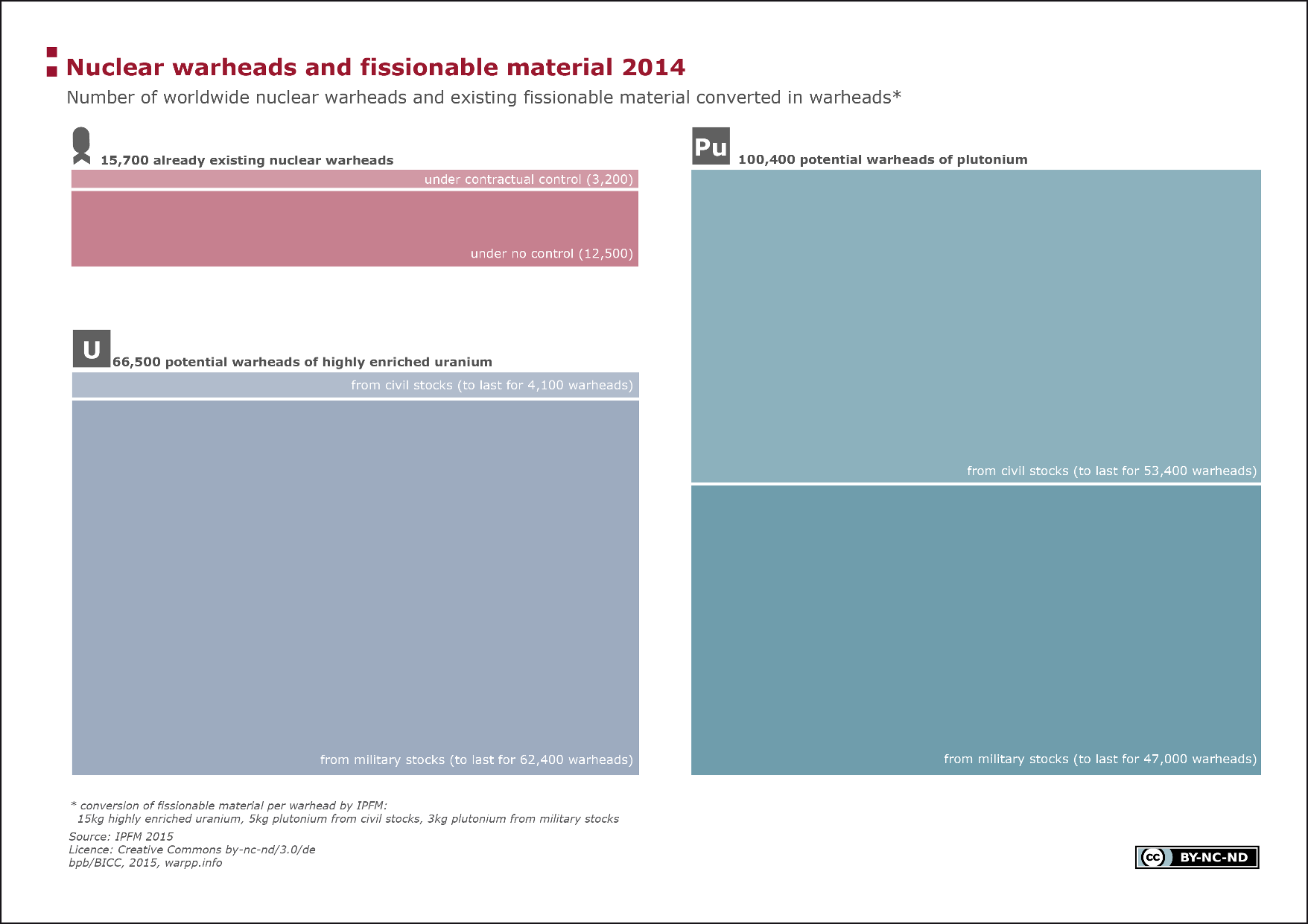Nuclear warheads and fissionable material 2014

This information graphics shows the number of nuclear warheads in the world as well as the number of warheads that could potentially be equipped with the available fissile material.
Facts
In 2014, there exited already 15,700 nuclear warheads 3,200 (20%) of these are subject to legal control mechanisms, 12,500 (80%) are subject to no legal control mechanism Of the uranium stockpiles, about six percent are civilian and about 94 percent military Of the plutonium stockpiles, about 47 percent are civilian and about 53 percent military From this material, 166,900 additional warheads can be equipped, which would exceed the number of existing nuclear warheads by more than 100-fold.
Nuclear weapons have so far only been used twice, in 1945, when the United States dropped one atomic bomb each over the Japanese cities of Hiroshima and Nagasaki. The atomic bomb dropped over Nagasaki in 1945 used plutonium as fissile material.
Terms, notes on methodology or reading aids
Nuclear weapons are weapons of mass destruction that derive their destructive force from nuclear reactions, the fission or fusion of the atom. To produce a nuclear weapon, either highly enriched uranium or separated plutonium is needed. Depending on the bomb size and the location of the explosion (in the air or on the ground), one single nuclear bomb can contaminate and/or destroy large areas and kill vast amounts of people. So-called radiological dispersal devices ('dirty bombs') do not fall under the category of nuclear weapons, as their destructive power stems from conventional explosives that scatter radiological material without causing either fusion or fission.
So far, only countries that have ratified the Non-Proliferation Treaty (also called the Treaty on the Non-Proliferation of Nuclear Weapons - NPT) declare their civilian and military weapons holdings Israel, India and Pakistan, three of the four countries that have not ratified the NPT are nuclear powers. The fourth country is South Sudan In January 2003, North Korea has declared its withdrawal from the NPT; the final status of North Korea has since been left pending by the NPT community There are only estimates regarding these countries' holdings The reported stockpiles are divided into five categories:
- Military: Military stockpiles,
- Civilian: Civilian stockpiles,
- Excess: Regained material from disarmed weapons,
- Naval: fissile material used by the navy (for instance as propellant for submarines)
- Disposed: fissile material that is to be disposed
Only figures of the categories military or civilian were used for this graphics
Weapons that were taken into account in the current NEW START agreement are subject to contractual control Weapons that were not taken into account by the agreement are declared as 'reserve' or 'not active' or for disarmament
Highly enriched uranium (HEU), produced in large facilities, is needed to produce an atomic bomb. An estimated value of HEU is at least US 10,000 dollars per gramme To be able to use uranium efficiently for nuclear weapons, its content of the fissile uranium isotope -235 must be increased by at least 85 percent. Only then does one refer to it as weapon-grade uranium. Is the content of the fissile isotope uranium -235 higher than 20 per cent, one refers to it as highly enriched uranium - HEU. As HEU can be used both for civilian and military purposes, it is a so-called dual-use item.
Natural plutonium deposits are only very small; it is, however, unavoidably created in larger quantities in fuel rods in nuclear power plants as a by product of neutron capture and beta decay, where some of the neutrons released by the fission process convert uranium-238 nuclei into plutonium-239. In these fuel rods, a mixture of various elements and isotopes is created when they are spent, amongst them the plutonium isotope-239, which is particularly fissile and therefore suited as nuclear explosive. Weapons-grade plutonium is defined as concentration of 90 per cent plutonium -239 and more. There are differing estimates as to how many kilogrammes of weapons-grade plutonium is needed at minimum to build an atomic bomb. It seems that between one and eight kilogrammes are necessary at least, depending on technical know-how and equipment.
The conversion to fissile material per warhead is done according to the definition of the International Panel on Fissile Materials (IPFM) According to this, 15kg of highly enriched uranium, 5kg from civilian stockpiles and 3kg of plutonium are needed to make nuclear warheads
Data sources
IPFM (International Panel on Fissile Materials) The IPFM initiative, founded in January 2006, has as its mandate to reduce the global production, storage and use of highly enriched uranium and plutonium. These two elements are the main components of nuclear weapons, and their reduction is intended to lead to more security with respect to the risks of a nuclear war and of terrorists being able to obtain access to these materials. These materials are used in nuclear power plants or are a by product of electricity generation. There is enough uranium and plutonium around to double the amount of nuclear weapons.





